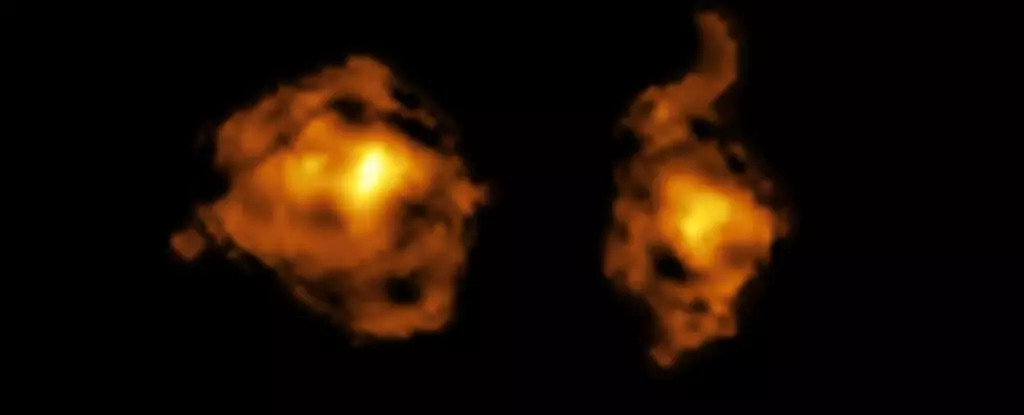In the deep tapestry of the universe, galaxies often engage in an intricate dance, colliding and merging over millions of years. Recent advancements in astronomical research have illuminated a riveting phenomenon — the so-called “cosmic joust,” where one galaxy unleashes a ferocious beam of radiation from its supermassive black hole onto another galaxy. This groundbreaking observation provides a clarion call to reevaluate our understanding of galactic evolution, revealing not just the violent interactions at play but also the devastating impact these events have on star formation.
The event, first pinpointed by astronomers, showcases how galaxies are not mere isolated structures but are embedded within a vast, complex web of dark matter. This invisible framework shapes their movements, guiding them into clusters that set the stage for inevitable collisions. Within these interactions, myriad factors influence the evolutionary fate of the participating galaxies — none more so than powerful quasars, which are galaxies with exceptionally bright centers driven by voracious black holes. This interaction, unmasked for the first time, lays bare the true dynamics between colliding galaxies manipulated by gravitational forces and energetic phenomena.
Quasars: The Galactic Juggernauts
Quasars, those luminous beacons of cosmic energy, arise from black holes swallowing matter at staggering rates. The process generates colossal heat and light — a spectacle for the eyes of modern telescopes. When a quasar speeds past a neighboring galaxy, it launches jets of energy that pierce into its galactic companion. This intrusion disrupts the delicate balance of gases that are essential for forming new stars. As jets erupt like cosmic lances, they blast through clouds rich in the dense materials from which stars are born, effectively suppressing their formation.
This energy is not just a bystander; it is a potent force that profoundly alters the trajectory of galactic evolution. One might envision this cosmic joust as a fencing match, where one competitor hurls energy and momentum at the other. The target, while still intact, inevitably suffers the consequences of this energetic assault. The wounded galaxy experiences a reduced capacity for star formation, its reservoirs of gas depleted, leaving it in a struggle to regenerate its stellar population.
The Duality of Destruction and Creation
However, even within these chaotic environments, an intriguing counter-narrative emerges. While the quasar’s fury quashes star birth in the galaxy it targets, the collision of gas pools can lead to remarkable new beginnings. As these galactic interactions unfold, areas with increased density can form, acting as fertile grounds for new star formation, despite the immediate violence of the quasar’s energy blast. In the grand scheme of cosmic time, disruption can often serve as a precursor to renewal and regeneration.
It is crucial to understand that quasar activity doesn’t solely wreak havoc on the neighboring galaxy. Each black hole, while consuming vast amounts of material, can inadvertently set off a feedback loop of galactic destruction and creation. Outflows from the quasar not only push away clouds necessary for its own star formation but also strip away material from the nearby galaxy, further complicating the dynamic between destruction and regeneration.
Implications for Cosmic Evolution
The revelations surrounding the cosmic joust provide essential insights into the larger framework of galactic evolution. Each collision and subsequent rescue mission, instigated by the delicate equilibrium of gravity and radiation, plays a pivotal role in shaping the universe as we understand it today. The metaphorical ash from one galaxy’s flames could very well serve as nourishment for another’s fiery birth.
The notion that even in the most catastrophic of galactic encounters, the genesis of new stars remains plausible, is both poetic and reassuring. As scientists uncover more instances of these cosmic jousts, we gain a clearer picture of how galaxies evolve in a universe marked by constant change. Amid destruction, it becomes evident that the intricate relationship between cosmic entities fuels the cycle of life among stars — a reminder that even amidst chaos, the potential for new beginnings continues to flourish.


Leave a Reply